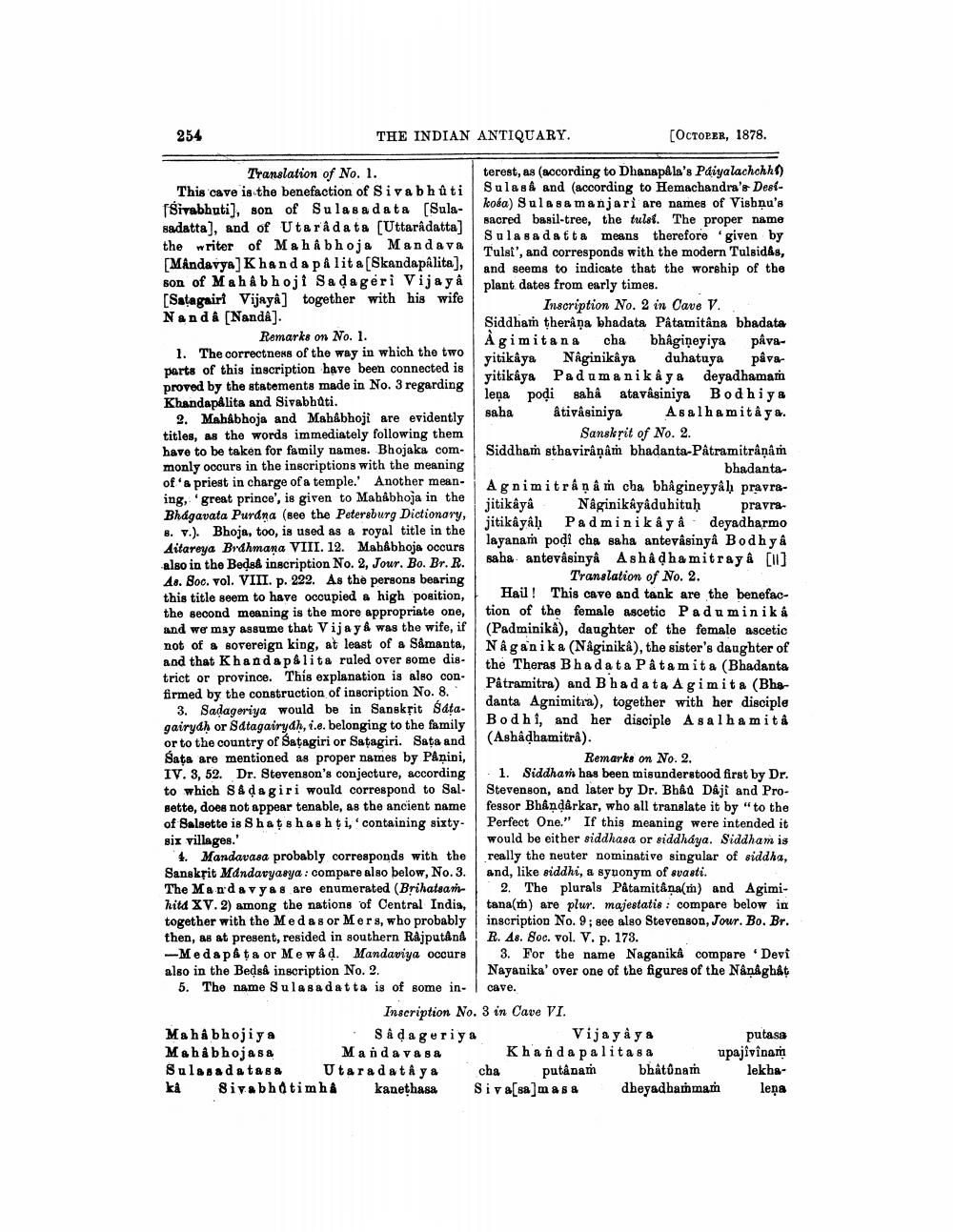________________
254
THE INDIAN ANTIQUARY.
Translation of No. 1.
This cave is the benefaction of Sivabhuti [Sivabhuti], son of Sulasadata [Sulasadatta], and of Utara data [Uttaradatta] the writer of Mahâbhoja Mandava [Mandavya] Khanda på lit a [Skandapâlita], son of Mahâbhoji Sadageri Vijaya [Satagairt Vijaya] together with his wife Nanda [Nanda].
[OCTOBER, 1878.
terest, as (according to Dhanapala's Paiyalachchht) Sulas & and (according to Hemachandra's Desikosa) Sula sa manjari are names of Vishnu's sacred basil-tree, the tuls. The proper name Sulasadatta means therefore 'given by Tulsi', and corresponds with the modern Tulsidas,
and seems to indicate that the worship of the plant dates from early times.
Inscription No. 2 in Cave V.
Siddham therana bhadata Pâtamitâna bhadata
Remarks on No. 1.
1. The correctness of the way in which the two parts of this inscription have been connected is
Agimitana cha bhagineyiya pâvaritikkya Nâginikaya duhatuya pâva
Khandapálita and Sivabhuti.
proved by the statements made in No. 3 regarding yitikaya Paduma nikaya deyadhamam lena poḍi saha atavâsiniya Bodhiya saha âtivâsiniya Asalhamitâya. Sanskrit of No. 2. Siddham sthavirânâm bhadanta-Pâtramitrânâm
2. Mahâbhoja and Mahâbhoji are evidently titles, as the words immediately following them have to be taken for family names. Bhojaka commonly occurs in the inscriptions with the meaning of a priest in charge of a temple.' Another meaning, great prince', is given to Mahâbhoja in the Bhagavata Purana (see the Petersburg Dictionary, 8. v.). Bhoja, too, is used as a royal title in the Aitareya Brahmana VIII. 12. Mahâbhoja occurs also in the Bedsâ inscription No. 2, Jour. Bo. Br. R. As. Soc. vol. VIII. p. 222. As the persons bearing this title seem to have occupied a high position, the second meaning is the more appropriate one, and we may assume that Vijay & was the wife, if not of a sovereign king, at least of a Sâmanta, and that Khandapâlita ruled over some district or province. This explanation is also confirmed by the construction of inscription No. 8.
3. Saḍageriya would be in Sanskrit Sáțagairydh or Satagairydh, i.e. belonging to the family or to the country of Satagiri or Satagiri. Sata and Sata are mentioned as proper names by Panini, IV. 3, 52. Dr. Stevenson's conjecture, according to which S&dagiri would correspond to Salsette, does not appear tenable, as the ancient name of Salsette is Shatshashti, containing sixtysix villages.'
4. Mandavasa probably corresponds with the Sanskrit Mandavyasya: compare also below, No. 3. The Mandavy as are enumerated (Brihatsamhitd XV. 2) among the nations of Central India, together with the Medas or Mers, who probably then, as at present, resided in southern Rajputânâ -Medapata or Mewåd. Mandaviya occurs also in the Beḍsâ inscription No. 2.
5. The name Sulasadatta is of some in
bhadanta
Agnimitrânâ m cha bhagineyyâh pravrajitikâyâ Naginikây duhituh pravrajitikâyâh Padminikâyâ deyadharmo layanam podi cha saha antevâsinyâ Bodhyâ saha antevâsinya Ashâḍhamitraya [1] Translation of No. 2.
Hail! This cave and tank are the benefaction of the female ascetic Paduminiká (Padminika), daughter of the female ascetic Naganika (Nâginikâ), the sister's daughter of the Theras Bhadata Pâtamita (Bhadanta Pâtramitra) and Bhadata Agimita (Bhadanta Agnimitra), together with her disciple Bodhi, and her disciple A salhamitâ (Ashâḍhamitra).
Remarks on No. 2.
1. Siddham has been misunderstood first by Dr. Stevenson, and later by Dr. Bhâu Dâji and Professor Bhandarkar, who all translate it by "to the Perfect One." If this meaning were intended it would be either siddhasa or siddháya. Siddham is really the neuter nominative singular of siddha, and, like siddhi, a synonym of svasti.
2. The plurals Pâtamitana(m) and Agimitana(m) are plur. majestatis: compare below in inscription No. 9; see also Stevenson, Jour. Bo. Br. R. 48. Soc. vol. V. p. 173.
3. For the name Naganikâ compare 'Devi Nayanika' over one of the figures of the Nânâghât
cave.
Mahabhojiya Mahabhojasa
Inscription No. 3 in Cave VI. Sâḍageriya Mandavasa
Vijayaya Khandapalitasa
Sulasadatasa Utaradatâ ya cha putânam bhâtûnam ka Sivabhatimhâ kanethasa
Siva[sa]m as a
dheyadhammam
putasa upajivînam lekhalena




